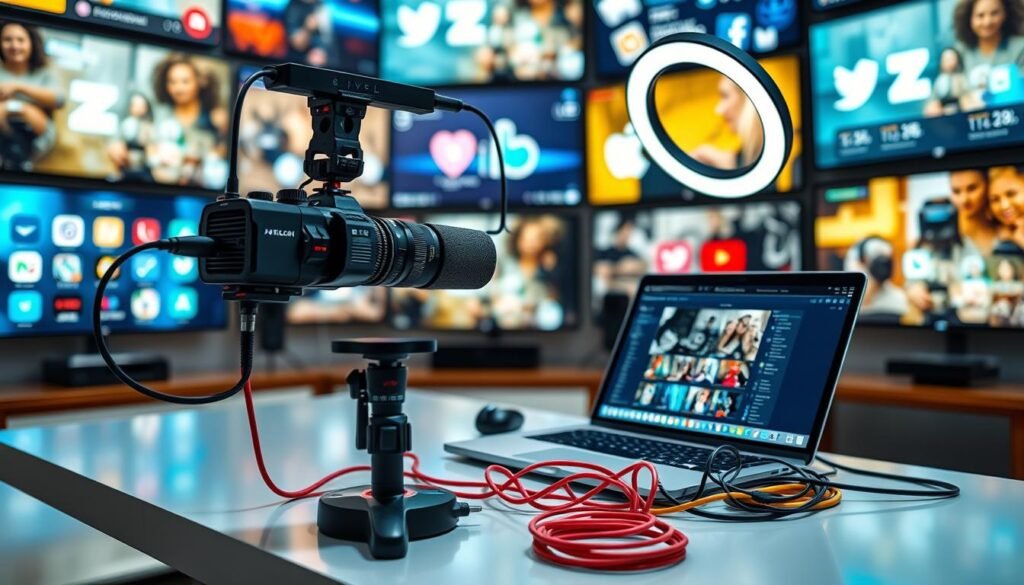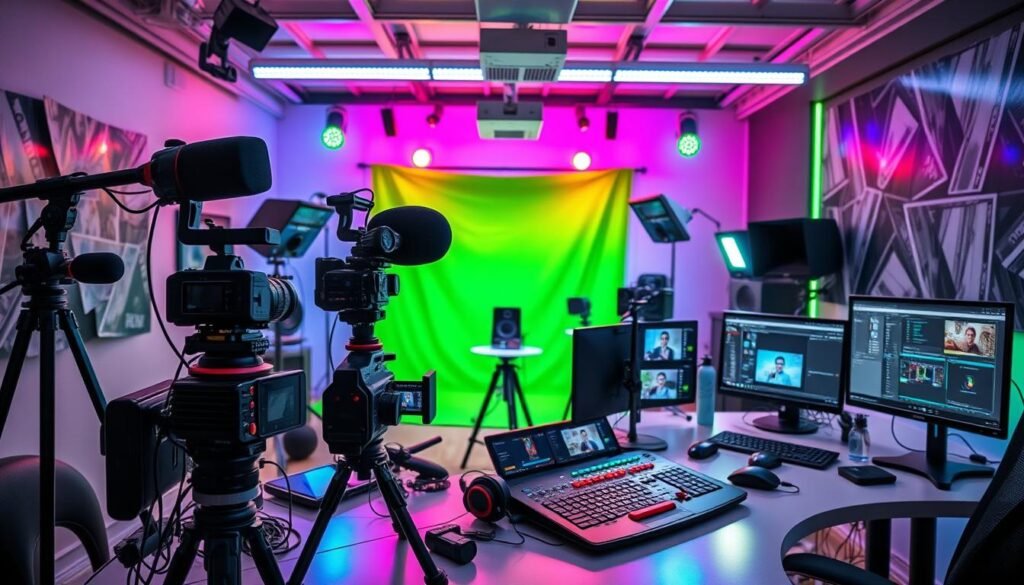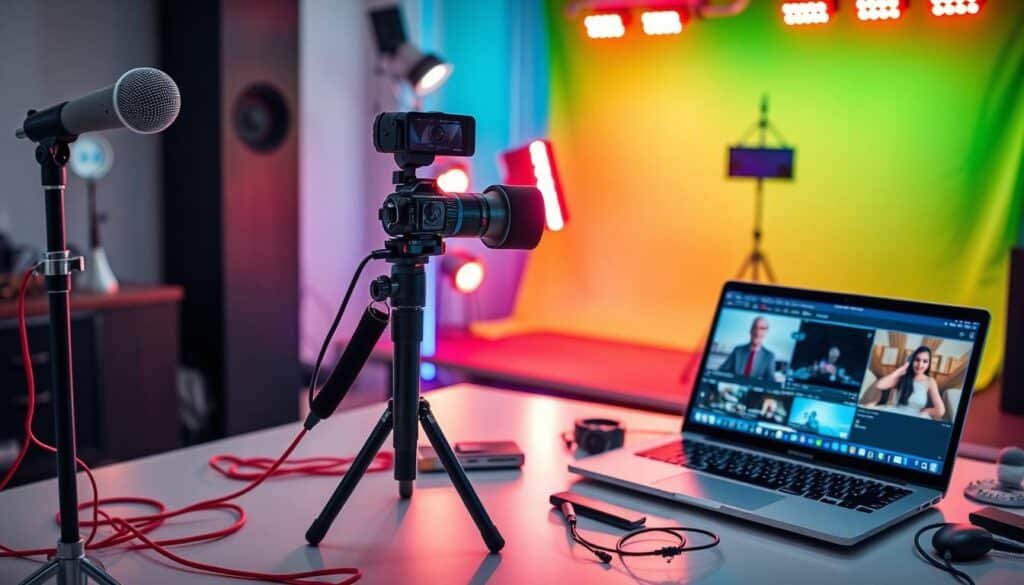Live streaming has become very popular, with a 300% increase in events from March to August 2020. It has grown by 99% year-over-year. Businesses, creators, and individuals use it to connect with their audience, show products, and share knowledge. This article will look at the best tools and platforms for live streaming success. We’ll cover essential equipment, popular platforms, and software to improve your broadcasts.
Key Takeaways : Live Streaming
- Live streaming has seen a significant increase in popularity, with a 300% surge in live streaming events from March to August 2020.
- Businesses, creators, and individuals are turning to live streaming to connect with their audiences in real-time and showcase their products or content.
- This article will explore the top tools and platforms for successful live streaming, including essential equipment, popular platforms, and valuable software.
- Live streaming can be a powerful tool for businesses and creators to engage with their audience and drive conversions.
- Choosing the right live streaming tools and platforms can make a significant difference in the quality and success of your broadcasts.
What is Live Streaming?
Live streaming is when you broadcast video live over the internet. It’s different from videos you watch later. Live streams let you watch and interact with content as it happens. This makes live streaming great for businesses and creators to connect with people in a real way.
Definition and Explanation of Live Streaming
Live streaming sends video live over the internet. The video is captured and sent out at the same time. This means viewers can watch as it’s happening, not after it’s uploaded. Live streaming lets people talk to each other in real time, creating a community feel.
Benefits of Live Streaming for Businesses and Creators
Live streaming has many benefits for businesses and creators. It lets them talk to their audience live, answering questions and sharing ideas. Businesses can show off products, teach, and even make money through donations. Creators can grow their fan base, share knowledge, and make their content feel special.
Also, live streams can be used later, making them even more valuable. The live stream commerce industry in China is expected to hit $423 billion by 2022. The US live streaming market is set to reach $25 billion by 2023.
“Live streaming has become an increasingly powerful tool for businesses and creators to connect with their audiences in a more authentic and engaging way. The ability to interact in real-time and the potential for generating revenue make it a must-have in today’s digital landscape.”
Essential Live Streaming Equipment

To make a live stream professional and engaging, the right equipment is key. You need devices for video and audio capture and accessories to improve your production. Quality equipment can greatly enhance your live stream.
Computers/Mobile Devices for Streaming
A reliable computer or mobile device is the base of a good live stream setup. Desktops offer more power and flexibility, while laptops are great for streaming on the go. Choose a device with at least 8GB RAM, a solid-state drive, and lots of USB ports for extra gear.
Video Cameras for Live Streaming
Good video quality is essential for a live stream. You can pick from simple smartphones to high-end DSLR cameras. Basic cameras work well in bright light, while pro cameras give better image and control for a polished stream.
Audio Equipment for Live Streaming
Audio is as important as video in live streams. Built-in mics can be okay, but dedicated mics like lavaliers or XLRs improve sound. Audio mixers help adjust levels for a professional sound.
Choosing the right live streaming equipment is crucial. This includes the right computers for live streaming, top-notch video cameras for live streaming, and the best audio equipment for live streaming. This will make your live streams better and keep your audience engaged.
“Video content is projected to account for 82% of all consumer internet traffic by 2025, and 85% of marketers credit video as an effective online marketing tool.”
Popular Live Streaming Platforms

There are many platforms for live streaming. Social media sites like YouTube Live, Facebook Live, and Instagram Live are very popular. They let you reach lots of people and get feedback through comments and reactions.
But, there are also third-party live streaming services for more control. Vimeo Livestream, Dacast, and OBS Studio offer features like multi-camera support and custom branding. They are great for both small creators and big companies, offering flexibility and professional tools.
Native Social Media Platforms
- YouTube Live: It’s part of YouTube, the biggest video site, and lets creators connect with their audience live.
- Facebook Live: This feature on Facebook lets users share live videos with their friends and followers.
- Instagram Live: Instagram’s live streaming lets users share live videos with their followers.
Third-Party Live Streaming Platforms
- Vimeo Livestream: Vimeo’s live streaming platform has advanced features and customization options for businesses and creators.
- Dacast: This platform offers a wide range of live streaming tools and services for businesses and creators.
- OBS Studio: It’s free software that lets users capture, record, and stream live video from their computers.
These are just a few of the many live streaming platforms out there. Each has its own special features. Whether you pick a social media live streaming platform or a third-party live streaming service, the right one can help you connect with your audience in real-time.
Live Streaming Tools and Software

Getting your live stream to play smoothly is key. That’s where video encoding and compression tools come in. Tools like OBS Studio and Zoom turn your video into formats you can stream. They also make the data smaller to cut down on buffering and boost quality.
These live streaming tools have cool features. You can adjust the resolution, frame rate, and bitrate. This helps you stream in top-notch quality.
There are also live streaming production software options for more advanced needs. Wave.video Live Streaming is one example. It has features like multi-camera support and customizable branding. It also lets you invite guests and edit your recordings.
These tools help make your live streams look and feel professional. They make your broadcasts more engaging and visually appealing for your viewers.
Video Encoding and Compression Tools
- OBS Studio – The best overall free streaming software, operating on Windows, macOS, and Linux, with completely free services and compatibility with platforms like Twitch, YouTube, and Mixer.
- Streamlabs OBS – Ideal for beginners, optimized for Windows operating systems.
- Nvidia Shadowplay – Best for basic streaming, with minimal impact on game performance and Windows compatibility.
- Xsplit Gamecaster – Best for streaming games to various platforms, works on Windows.
Live Streaming Production Software
These live streaming production tools offer advanced features for professional broadcasts:
- Wave.video Live Streaming – Offers multi-camera support, customizable overlays, guest invitations, and the ability to repurpose live stream recordings.
- vMix – Provides live video mixing, switching between multiple cameras, and the integration of various media sources.
- Wirecast – Allows for seamless switching between multiple cameras, overlaying graphics, and streaming to multiple platforms simultaneously.
“Selecting the right video camera and audio equipment is crucial for the quality of a live stream or broadcast.”
Live Streaming Tips and Best Practices

To make your live streams a hit, follow some key best practices. First, make sure your internet connection is strong and clear of interference. This ensures your video and audio are top-notch. Also, test your equipment and setup early to catch any tech issues before the big day.
Keep your viewers hooked with interactive stuff like polls and Q&A sessions. It’s fun for them and gives you valuable feedback. Don’t forget to promote your live stream on social media and in emails. This helps you reach more people and boost viewership.
It’s vital to check how your live streams are doing and what people like. Use this info to make your content better and your promotions more effective. Plus, use your live stream recordings as on-demand content. This way, you get more value out of them and reach more people.
- Optimize your internet connection and minimize potential interference
- Test your equipment and setup well in advance of the live stream
- Engage your audience through interactive features like polls and Q&A
- Promote your live stream across multiple channels to reach a wider audience
- Analyze viewership and engagement data to continuously improve your live streaming efforts
- Repurpose and leverage your live stream recordings as on-demand content
| Live Streaming Best Practices | Key Benefits |
|---|---|
| Optimize internet connection and test equipment | Ensures smooth, high-quality live streams |
| Engage audience with interactive features | Increases viewer engagement and retention |
| Promote live streams across multiple channels | Expands reach and attracts a larger audience |
| Analyze data to improve live streaming strategies | Allows for data-driven decision-making and continuous optimization |
| Repurpose live stream recordings | Maximizes the value and longevity of live content |
By using these live streaming tips, you can make your streams better, more engaging, and successful. The live streaming market is growing fast. So, it’s key to get good at these strategies to stay ahead and connect with your audience online.
“Live streaming is the future of content consumption, and brands that embrace it will have a significant advantage in engaging with their audiences.” – Industry Analyst
Also Read : Stay Tuned: Eagles Radio Broadcast, The Ultimate Fan Experience!
Conclusion
Live streaming is now key for businesses, creators, and people to connect live. It lets you share moments in real-time, making your content more engaging. With the right tools and knowledge, you can make your live streams stand out and reach your goals.
Live streaming has changed how we connect with our audiences. It’s a great way to show off products, share knowledge, and build strong relationships. Knowing the basics of equipment, platforms, and software is crucial for making high-quality streams.
The live streaming world is growing fast. Businesses and creators who use it well can reach more people, grow their brand, and sell more. Live streaming offers many benefits, like more audience interaction, credibility, and content reuse, helping you grow and succeed.
FAQs
Q: What are the best live streaming platforms available?
A: Some of the best live streaming platforms include YouTube Live, Facebook Live, Twitch, and various streaming services that offer features tailored for content creators and businesses. Each platform has its unique features and audience, so it’s important to choose the one that aligns with your goals.
Q: How do I start live streaming on platforms like Facebook Live?
A: To start live streaming on Facebook Live, you need to log into your Facebook account, go to your profile or page, and select the ‘Live’ option. From there, you can use the built-in streaming app or an encoder to set up your broadcast, add a description, and go live instantly.
Q: What do I need to get started with live streaming?
A: To get started with live streaming, you’ll need a reliable internet connection, a good quality camera (either built-in or external), a microphone for clear audio, and an encoder or streaming software to manage your live video. Additionally, having a streaming app can enhance your viewing experience.
Q: What is the meaning of live stream in the context of online broadcasting?
A: The meaning of live stream refers to the real-time transmission of video and audio content over the internet. This allows viewers to watch live broadcasts as they happen, making it ideal for virtual events, webinars, and interactive sessions like live polls and Q&As.
Q: Can I use a mobile app for live video streaming?
A: Yes, many streaming services offer mobile apps that enable content creators to broadcast live video directly from their smartphones. These apps are designed to provide a seamless experience for both streamers and viewers, often including features like live chat and instant sharing capabilities.
Q: How can I improve viewer engagement during my live streams?
A: To improve viewer engagement during your live streams, consider incorporating interactive elements such as live polls, Q&A sessions, and live chat. Engaging with your audience in real-time and responding to their comments can significantly enhance their viewing experience.
Q: What are some common challenges faced by live streamers?
A: Common challenges faced by live streamers include technical issues like poor internet connectivity, audio or video quality problems, and managing viewer engagement. To overcome these challenges, it’s essential to test your setup beforehand and have a backup plan in case of technical difficulties.
Q: How do I choose the right encoder for my live broadcasts?
A: Choosing the right encoder for your live broadcasts depends on your specific needs, such as the quality of the video stream you wish to produce and the platform you are using. Look for an encoder that supports RTMP streaming technology and is compatible with your chosen streaming service.
Q: Are there any special features offered by the best live streaming services?
A: Yes, the best live streaming services often offer a variety of special features including high-definition video options, integrated chat functions, analytics tools to track viewer engagement, and options for monetization like subscriptions and donations.
Source Links
- https://streamyard.com/blog/live-streaming-software
- https://www.dacast.com/blog/10-best-live-streaming-platforms-for-pros/
- https://en.wikipedia.org/wiki/Live_streaming
- https://riverside.fm/blog/what-is-live-streaming
- https://www.dacast.com/blog/live-streaming-equipment/
- https://castos.com/live-streaming-setup/


